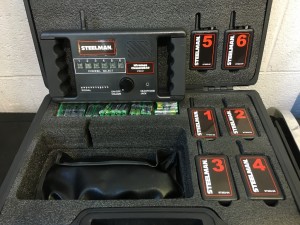As a professional automotive technician, a good set of wireless chassis ears are a great addition to the tool box. I have spent the last 13 years of my career diagnosing noises. Everything from a click while turning left, to a slight pop when making a slight right on Tuesdays in the rain. Okay, that last one may have been an exaggeration, but noise diagnosis can be tricky. This is especially true when the car needs to be driven to reproduce the noise. Enter the Steelman Wireless Chassis Ears.
What is in the box?
The basic wireless chassis set comes all you need to get started diagnosing chassis and other vehicle noises. The kit included
- The receiver unit
- 4 transmitters
- Velcro scraps to secure transmitters
- 4 clip on sensors
- 6AA and 16AAA batteries
- Instruction manual
- Note pad for documenting locations of sensors
- Blow molded storage case with foam cutouts for kit
- Ear phones
- 2 extra transmitters are sold separately
The Setup
Once of the great things about wireless chassis ears is not having a bunch of long cables to tend to. No more worrying about a cable becoming loose and getting caught in the axle. Something I have seen happen before. Positioning the transmitters in the proper locations is key for accurate diagnosis. Since the Steelman kit comes with four sensors, you can place the sensors in different locations to really pinpoint the noise.
Each sensor is equipped with 2 internal magnets for attaching to a ferrous metal. I would highly recommend using the provided tie wraps or velcro as a back up form of security. I hate to lose or damage a transmitter. While the magnets are very strong, there is no reason to be a hero. Once you have the appropriate number of transmitters set and secure, document the position of each sensor.
The Test Drive
Before we talk about using these chassis ears, always be sure to have one person driving the vehicle, and someone else monitor noises. Attempting to drive a car and listen for noises can lead to distracted driving.
With the sensors all hooked up and secured, it’s time for a road test. The Steelman makes it easy to switch back and forth between channels with a simple press of a button. Monitoring the transmitters for noise can be done two different ways. Monitoring is done visually with a series of lights on the receiver unit. From my experience the unit works better by using audio to pin point issues. This can be done in one of two way
- Using the built in speaker from the receiver unit
This is an adequate was of monitoring each channel. The speaker works, and it is a nice back up. I experienced a slight amount of distracting feedback. - Using the earphone jack on the receiver unit
The Steelman unit comes with a 3.5mm earphone jack. It also comes with earphones to monitor the transmitters. I found earphones to be a much better way to use the tool. If this tool will be getting some heavy use, I recommend upgrading the earphones to over the ear headphones. That will be more comfortable and provide a cleaner sound.
The key here is comparing the noise between channels. If channel 1 is placed on the left side of the car, channel 2 is on the right, and 3 is in the middle, we switch between each channel to find where the noise is coming from. This may require adjusting the volume level of each channel. The sensors may also need to be moved as you come closer to isolating the noise.
Chassis ears, wireless or not, are a great addition to a toolbox. Isolating suspension noise is just the beginning. Almost any type of noise can be detected by the transmitters units. Things like wheel bearing noise, transmissions, alternators, power steering pumps, even fuel injectors can be tested.
Overall the Steelman Wireless Chassis Ears were able to detect the noises as expected. I would recommend getting some practice with transmitter placement, and comparing channels. This is the type of tool that becomes better with experience. I would also recommend upgrading the earbuds. I found them to be the weak point of the kit. Sounds quality was fair, but they were not comfortable to wear for an extended period of time. One final note, The Steelman takes a lot batteries. I would recommend not leaving them in the receiver or the transmitters. I would also think about switching to rechargeable batteries.







